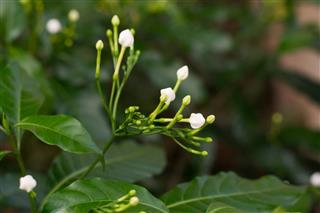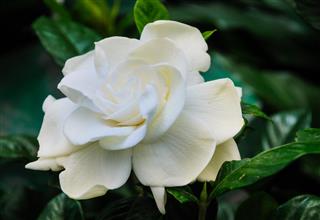
Though gardenias are hardy shrubs, they are susceptible to various diseases and pests, especially when the plants are in a stressed condition. Read on to know about some of the most destructive gardenia shrub diseases and their remedies.
Gardenia shrubs work wonders for any type of garden and landscape design. The beautiful white blooms and their fragrance can liven up any area, be it indoors or outdoors. With proper care, you can maintain healthy gardenias free of diseases and pests. Nevertheless, growing these shrubs indoors is a bit challenging, as they require abundant sunlight, high temperatures, and humidity.
Care Tips
Gardenias are native to tropical and sub-tropical climates. Hence, they perform best when provided with the same growing conditions as their natural habitat. Also, timely blooming depends on availability of these requirements. Many of us are not aware of how to grow and care for gardenia shrubs. Here are some pointers for those of you who fall into this category:
- Temperature: Gardenias require warm, but not hot, (about 65-75°F) temperature for proper growth and timely flowering.
- Sunlight: Plant a gardenia shrub in areas that receive indirect sunlight for a prolonged duration.
- Humidity: Daily misting or soaking the container in water is ideal for providing the correct range of humidity to these shrubs.
- Fertilizer: Feeding this shrub with a slow release fertilizer should be done once every 2-3 weeks.
Identifying the Diseases
When winter arrives, extra care is required for maintaining your gardenias in a healthy condition. Avoid pruning the plants during cold weather; instead, you can trim the branches immediately after the blooming period. Understanding the tips for gardenia care in winter will help you in preventing the onset of diseases and pest infestation.
- Yellowing of Leaves:
Leaves turning yellow is not actually a pathogen-related disease, but is caused by excess watering of the plants and high pH of soil. In order to avoid such a problem, follow the watering instructions as directed by a horticulturist. If a high pH is the reason, supplement the soil with additives to maintain a pH range between 5.0-6.5. - Dropping of Buds:
Imagine that your gardenia shrubs develop flowering buds and eventually they drop. This dropping of buds is one of the most common problems associated with this shrub. Similar to foliage yellowing, bud dropping is caused due to improper growing conditions. So, in order to solve this problem, check and maintain the soil and humidity levels. - Stem Canker:
Canker is the most destructive plant disease that leads to stunted growth or, at times, even death of the plant. The affected stem is swollen and the plant dies slowly. There is no preventive measure for this disease. You can prune the branches of the shrub whenever you notice any signs of this disease. This will prevent spreading of the fungus to other plant parts. - Leaf Spot:
Leaf spot diseases in gardenia are caused due to infestation by bacteria and/or fungi. Depending upon the causal organism, the affected leaves turn yellowish, reddish, or brownish in color and ultimately fall off. In case of heavy attacks, you can make use of pesticides. However, do this only under the jurisdiction of a professional pest control service. - Powdery Mildew:
Powdery mildew is a white, powdery fungal disease that affects nearly all parts of the gardenia shrubs. This is often caused due to close plantation of the plants and very high humidity levels. Avoid water retention in the leaves and stem to prevent this disease. You can prune the severely infected parts and spray them with a correct concentration of fungicides. - Sooty Mold:
White flies indirectly cause infestation of sooty molds by leaving a honeydew-like substance wherever they feed on the gardenia plants. These molds then feed on this honeydew substance, making a black film over the foliage and stem. Killing the white flies and spraying the shrubs with an appropriate fungicide will help in controlling this disease.
With this information, I hope you can maintain healthy plants and identify the symptoms of diseases as soon as possible. Provided that the growing conditions are optimal, a disease-free and matured gardenia shrub will bloom to its fullest during the summer months.

